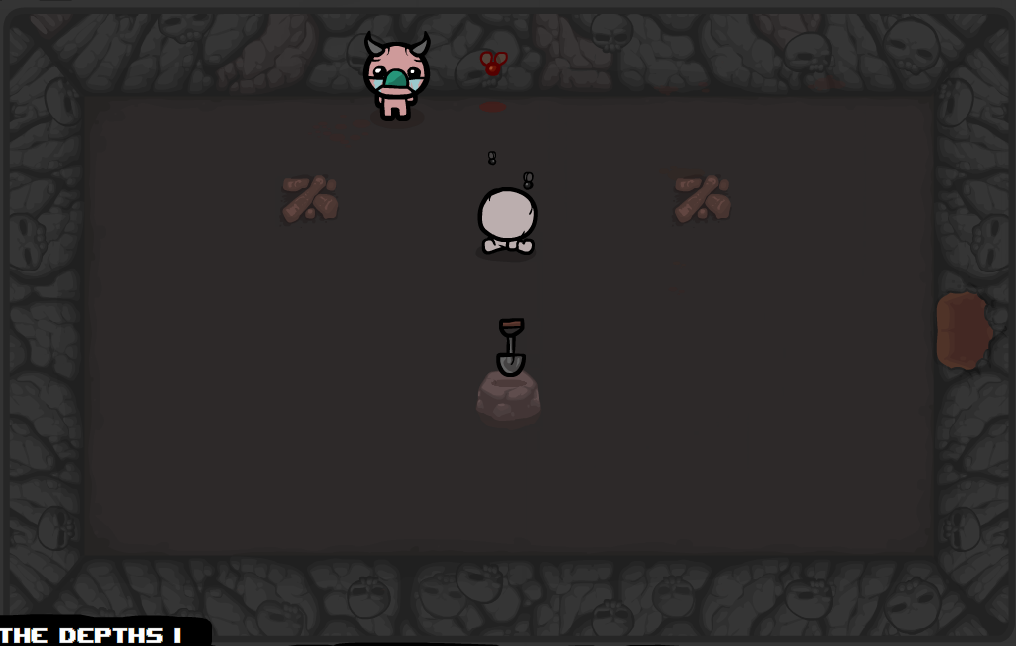The Binding of Isaac is one of the best examples of the gothic literary tradition translated into a video game to date. A good number of key genre tropes are on display: madness, religion, setting, family, and death. Don’t let the style of the graphics be misleading. This all adds up to a surprisingly dark experience. It’s as if Edgar Allen Poe has risen from the grave to create a game!
Players who start The Binding of Isaac for the first time are greeted by a cut scene detailing the events leading up to the start of the game. Isaac’s mom has heard the voice of God three times, and each time this voice tells her that Isaac’s soul is in danger. The first time she takes away all of his belongings and the second time the voice speaks she locks Isaac in his room. Lastly the voice tells her to prove her faith to it by killing Isaac, mirroring the Biblical tale where God tells Abraham to sacrifice his son for the same reason.
The mom’s insanity is the catalyst that sets off the game’s events. From Edgar Allen Poe’s The Tell-Tale Heart to the more recent Drood by Dan Simmons, mentally unsound characters are featured prominently throughout the gothic. They bring reality into question and show us how far off the rails the human mind can go. Isaac’s mom is pretty far off the rails judging by the crazed looks on her face while performing the voice’s work. There is also little question as to whether or not Isaac’s mom is actually hearing God judging on the contents of their basement.

'There came forth only a jingling of the bells.' – The Cask of Amontillado
The basement brings about another point: family. Who are all of these hideous mutants living out their sunless lives beneath Isaac’s home? Probably siblings he never knew he had. Family is an important and recurring theme in the gothic. The events in the first gothic novel ever published, The Castle of Otranto, are driven by patriarch Manfred’s paranoia that his family line is at an end with the death of his son. In a later example, the nameless narrator in The Shadow over Innsmouth learns things about his family better left forgotten. Similarly, Isaac discovers the horrifying truth about his own family by confronting his deformed brethren in an attempt to escape from their mother.
The setting of this game also conveys darkness typical of the genre. Historically, gothic stories center on dank and aged settings. The Castle of Otranto is set in the titular Castle Otranto, The Pit and the Pendulum is set in a Spanish Inquisitorial dungeon, and The Cask of Amontillado takes place in a basement. (Sound familiar?) Even the secret rooms in the game echo the imprisonment of Fortunato behind a wall in The Cask of Amontillado. Each secret room in The Binding of Isaac is sealed and inside every one of them is a corpse.
Religion is another oft appearing motif throughout the game; it’s central to the plot and theme, and there are numerous religious objects the player can pick up. Religion isn’t cast in a good light here which is true for most gothic works. Matthew Gregory Lewis’ The Monk, first published in 1796, centers around an especially pious monk named Ambrosio who ends up selling his soul to Satan. Isaac can sell his soul to the devil too. In exchange for health, the player can gain powers such as extra lives and demonic wings. The game makes trading your soul to the First of the Fallen easy, but it is a double-edged sword. Just as Dr. Faustus and Tom Walker eventually lost their lives by selling their souls, so does Isaac.

"I am yours for ever and irrevocably!' cried the Monk wild with terror: 'I abandon all claim to salvation! I own no power but yours!" – The Monk
Lastly, The Binding of Isaac focuses on one of the most important themes in the gothic: death. The number of titles that feature death as a theme is vast, but some of the best examples are The Legend of Sleepy Hollow, The Masque of the Red Death, Dracula, and The Haunter in the Dark. Death is a prominent and inescapable presence in all of those works, just as it is in The Binding of Isaac. This is communicated in-game by constant player death. Dying here is no different than dying in a roguelike; death is permanent and the game is restarted when it befalls Isaac. At the time of this writing I’ve personally died thirty-six times over the course of eight hours. Death is ever present, nipping at Isaac’s heels until it consumers him.
The Binding of Isaac uses the title of a biblical story, but it has the beating heart of one of the gothic greats. If you’re looking for a game just as dark and twisted as something that unfurled itself from the mind of Poe or Lovecraft, look no further than The Binding of Isaac.
Interested in further gothic reading? Here’s a full list of my examples from above with a few extra thrown in for good measure (and they all make great October reads):
The Castle of Otranto by Horace Walpole
The Monk by Matthew Gregory Lewis
Dracula by Bram Stoker
Frankenstein by Mary Shelley
The Strange Case of Dr. Jekyll and Mr. Hyde by Robert Louis Stevenson
The Devil and Tom Walker and The Legend of Sleepy Hollow by Washington Irving
Drood by Dan Simmons
H.P. Lovecraft and Edgar Allen Poe wrote too much to list here, but they’re most certainly worth a look.
VentureBeat's mission is to be a digital town square for technical decision-makers to gain knowledge about transformative enterprise technology and transact. Learn More
